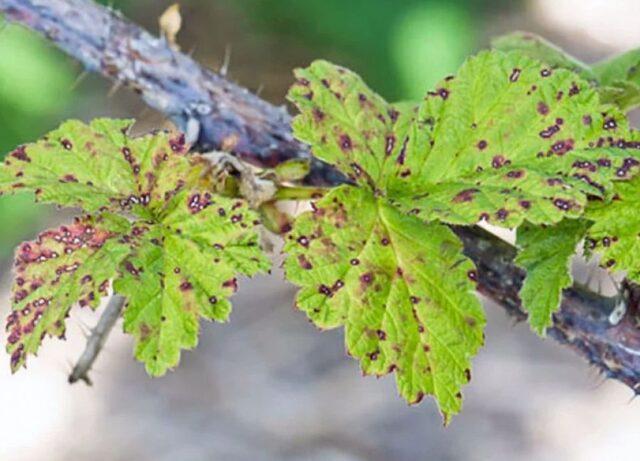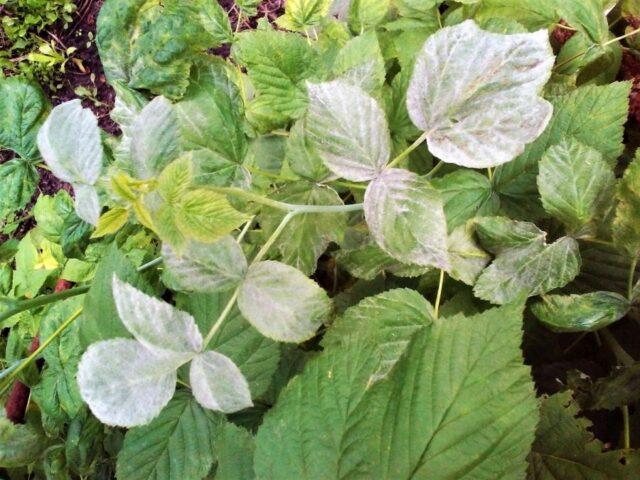Content
Raspberry leaves curl - gardeners usually encounter this problem in late spring and summer. Deformation of the plates can be caused by several reasons, including improper care and exposure to infections and insects.
Why do raspberry leaves curl?
Diseases, poor growing conditions, or pest attacks can lead to deformation of raspberry leaves. To understand exactly why the plates curl, it is necessary to conduct a careful inspection of the bush.
Lack of minerals
If there is no plaque, no stains, no traces of insect activity on the raspberry leaves, but the plates still curl, the problem is most likely a lack of nutrients. Shrubs especially often suffer from a deficiency of:
- nitrogen - with a deficiency of this element, the development of raspberries slows down;
- potassium and phosphorus - with a lack of minerals, the plant’s endurance decreases, the shrub absorbs other nutrients coming from the soil less well;
- gland - the leaves usually not only curl, but also turn yellow, although the veins often remain green.
It is recommended to feed raspberries for good growth in early spring. For the first time, fertilizers are applied immediately after the soil thaws. When first feeding, it is better to use ammonium nitrate or urea, as well as wood ash.

In summer and closer to autumn, the shrub can be fed with complex potassium-phosphorus mixtures
Lack of moisture
During dry periods, raspberries may suffer from lack of water. The roots of the shrub are located close to the surface and do not reach the deep layers of the soil, in which moisture may remain. In the absence of rain and watering, the leaves of the plant often curl, change color and begin to fall off.
In dry weather, it is recommended to moisten raspberries at least once a week. On average, from the end of spring to the beginning of autumn, 7-8 waterings are carried out for the plant.
Diseases
The leaves of the bush curl due to viral and fungal diseases. Illnesses interfere with normal nutrition of the plates and provoke deformations. Ultimately, the leaf tissues are destroyed and the raspberry crown crumbles ahead of time.
Chlorosis
Chlorosis of raspberry leaves can be non-infectious and viral in origin. In the first case, it is caused by sudden temperature changes and excess nitrogen in the soil, in the second by pathogens that penetrate the tissue through damage to roots and shoots. Against the background of chlorosis, the production of chlorophyll in the required quantities is disrupted, the leaves curl and become yellow.
An illness of non-infectious origin can be eliminated with the help of complex fertilizing and spraying with iron sulfate.If the chlorosis is viral, then all that remains is to remove the raspberries from the area, since there is no treatment in this case.

Chlorosis affects the fruiting of raspberries and leads to crushing and drying of the berries
Curly
Viral raspberry curl, as its name suggests, causes the leaves of the bush to curl, dry out at the edges and darken. The shoots stop growing and thicken, yields drop, and the berries become watery and tasteless.
It is impossible to cope with curliness; the affected raspberries need to be dug up and burned. Neighboring shrubs are then sprayed with fungicides to prevent the spread of aphids - this parasite is the carrier of the virus.

Raspberry leaf curl often develops with high humidity and insufficient ventilation of the bushes.
Rust
The fungal disease appears as a bright orange, bumpy rash on the underside of raspberry leaves. Over time, the plates curl and fall off en masse, the shoots of the bush weaken and become thinner.
Rust fungus quickly spreads throughout the area. When the first symptoms occur, it is necessary to remove all affected parts of the plant and treat the raspberries with copper sulfate or Bordeaux mixture. If the bush is not too severely affected, then there is no need to destroy it entirely; it may well recover.

Spraying against rust is carried out 2-3 times with an interval of two weeks.
Fungal anthracnose
Anthracnose often affects raspberries in acidic soil and with a lack of phosphorus and potassium. The disease manifests itself as brown spots on stems and leaves; over time, the marks become purple in color. The plates curl and dry, and then begin to fall off.When the disease is advanced, ulcers with a dark rim along the edges appear on the branches of the bush, the bark becomes coarser and cracks.
Anthracnose is combated using the drugs Quadris, Abiga-Pik and similar fungicides. Spraying is carried out according to the instructions several times at two-week intervals.

Anthracnose fungus develops in high humidity and temperatures around 22 °C
Powdery mildew
In conditions of high humidity, raspberries in the area are often affected by powdery mildew. The disease can be recognized, first of all, by a whitish coating on the plates; as the disease develops, the leaves curl and dry out. With severe damage, raspberry yields drop by up to 50%, and the growth of new shoots is reduced.
The disease responds well to treatment in the early stages; the drugs Topaz, Fitosporin-M and Tiovit Jet can be used to get rid of powdery mildew. It is necessary to trim the raspberries and remove the affected shoots.

In the early stages, powdery mildew plaque can be easily rubbed off with a finger, but over time it becomes denser
Pests
Raspberry leaves curl when the bush is damaged by pests. Insects draw juices from the plant, as a result of which the plates become deformed and quickly die.
Aphid
The insect reproduces in large colonies and can densely cling to entire raspberry shoots. Under the influence of the pest, the plates of the bush curl, acquire an unnatural shine, and then dry out and fall off. Most often, aphids attack raspberries in July and August in hot and humid weather.
If the infestation is mild, you can get rid of the pest using a solution of laundry soap or ash. If there are a lot of insects, it is better to use industrial insecticides - Karbofos, Actellik and others.

Aphids are carriers of mosaic and curl viruses, which further weaken raspberries.
Stem fly
The pest attacks raspberries most often in mid-May. The insect lays eggs in the axils of the leaves; the hatching larvae begin to feed on plant sap and gnaw passages inside the shoots. The blades of the bush curl and change color, and young branches begin to rot.
To eliminate the stem fly, the insecticides Iskra and Karbofos are used. As a preventive measure, in the fall and spring, carefully dig up the soil under the bushes, since some of the larvae overwinter in the ground.

Raspberry shoots affected by the stem fly are cut down to the ground
Weevil beetle
Raspberry leaves curl under the influence of the weevil, which becomes active at the end of April or May when the soil warms up to 10-15 ° C. Damage to the crop is caused by both adult insects feeding on the sap of the plates and larvae. When damaged by a weevil, raspberries slow down in development. The insect lays eggs in the buds of the plant, so the crop begins to bloom and bear fruit worse.
You can eliminate the weevil by spraying with insecticides. In spring, shoots must be inspected daily and, if necessary, beetles must be collected manually. If the insects have managed to lay eggs, then the damaged buds need to be cut off and destroyed.

Raspberries often suffer from weevils in close proximity to strawberries and wild strawberries.
What to do if raspberry leaves curl
If the raspberry leaves curl, then the first step is to spray with preparations containing copper - vitriol or Bordeaux mixture. These solutions have a good effect on most fungal diseases and strengthen the overall endurance of the shrub. If there are obvious presence of pests on the shoots, you need to treat them with an industrial or homemade insecticidal solution.
If the bush is visually in order, but the leaves are still curling, it is worth reviewing the watering and fertilizing schedule. Raspberries urgently need to be fertilized with complex minerals, watered abundantly and loosened the soil. In the future, it is necessary to carefully monitor the level of soil moisture and its composition.
Prevention
Often the leaves of raspberry bushes curl when it is too late and pointless to treat the crop. It is recommended to give priority attention to prevention, namely:
- carefully inspect seedlings before planting and do not use plants with damaged roots and shoots;
- in spring and autumn, carry out sanitary cutting and thinning of bushes;
- regularly feed raspberries with complex minerals containing potassium, nitrogen and phosphorus;
- Spray the plantings with Bordeaux mixture starting in early spring.
An important stage of prevention is maintaining cleanliness in the garden area. In the fall, all plant debris in the raspberry field is removed. Fungi and pests that cause leaf curl usually overwinter in the soil.

When the soil is loosened in autumn, fungal spores and larvae appear on the surface and die during frosts
Conclusion
Raspberry leaves curl usually under the negative influence of pests and fungi.Less commonly, a severe lack of moisture or nutrients in the soil leads to deformation of the plates. To maintain the health of the bush, you need to follow the rules of agricultural technology and devote time to disease prevention.








